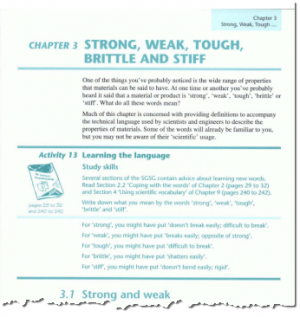The Material World: Difference between revisions
No edit summary |
No edit summary |
||
| (30 intermediate revisions by 4 users not shown) | |||
| Line 1: | Line 1: | ||
{| | {{ResourcePageGroupMenu|OU Breakthrough MST}} | ||
| | {{Rinfo | ||
|type= Teacher Education | |||
| | |attribution={{OpenLearn}} | ||
| | |title=The Material World | ||
| | |tagline=Exploring the properties of materials around us. | ||
| | |image=Thematerialworld1.png | ||
| | |topic=Materials | ||
| | |subject=Science | ||
| | |resourcenumber=TE005 | ||
| | |age=Primary, Higher, Secondary, | ||
| | |content=An Open University study module. | ||
| | |strategy= | ||
|Learning Objectives=Students should understand that: | |||
* many different materials make up the world around us, | |||
* we can classify materials in three main groups: metals, polymers and ceramics plus natural composite such as wood and bone, | |||
* materials are chosen for applications on the basis of the properties they possess.<br /> | |||
| | |||
| | Students should be more able to: | ||
| | * draw up a timetable to help them plan their study, | ||
| | * make brief notes to clarify their understanding, | ||
| | * review their study strategy and reflect on what they have learnt. | ||
| | |additional resources= | ||
|useful information=This will be of particular interest to teachers who are not chemists. | |||
|related resources= | |||
|other= | |||
|format= | |||
|final=yes | |||
|resources=Follow the link to a study unit divided into [http://labspace.open.ac.uk/mod/oucontent/view.php?id=426185§ion=1.2.3%20 9 PDF documents] | |||
(Part of the Breakthrough to Mathematics, Science and Technology Series) | |||
}} | |||
[[Category:Primary]] [[Category:Secondary]][[Category:Science]][[Category:Teacher Education]] [[Category:External Resource]] | |||
[[Category:Materials]] | |||
Latest revision as of 14:05, 5 December 2012
About. An Open University study module.
Pedagogical content. Designed to encourage active learning(ta), this study module explores the properties of materials from everyday life.
It also involves some simple inquiry(ta) and practical activities using household items. (edit)
| Resource details | |
| Title | The Material World |
| Topic | [[Topics/Materials|Materials]] |
| Teaching approach | [[Teaching Approaches/Active learning|Active learning]], [[Teaching Approaches/Inquiry|Inquiry]] |
| Learning Objectives | Students should understand that:
Students should be more able to:
|
| Subject | [[Resources/Science|Science]] |
| Age of students / grade | [[Resources/Secondary|Secondary]], [[Resources/Primary|Primary]], [[Resources/Higher|Higher]]
|
| Useful information | This will be of particular interest to teachers who are not chemists.
|
| Files and resources to view and download | Follow the link to a study unit divided into 9 PDF documents (Part of the Breakthrough to Mathematics, Science and Technology Series)
|

